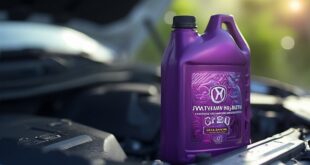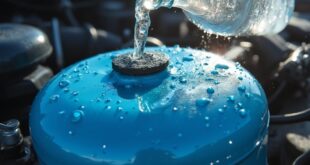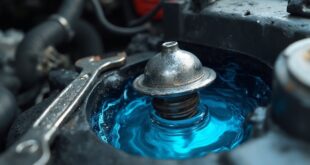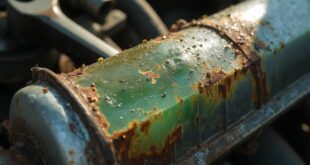Your coolant overflow tank should stay between the minimum (L) and maximum (F) markings. Aim for a fill level slightly above 30% for ideal engine health. This guarantees adequate coolant circulation, preventing overheating and potential damage. Be sure to check the levels regularly and maintain them properly. If you're curious about the role of coolant in engine performance and how to check levels correctly, there's plenty more to explore!
Understanding Coolant Overflow Tank Levels
When you check the coolant overflow tank levels, it's crucial to confirm they're within the recommended range to maintain engine health. Aim for a minimum fill level of at least 30%, ideally slightly above the minimum line marked on the tank.
Regularly inspecting these levels prevents issues, as both underfilling and overfilling can be dangerous. The markings on the tank indicate minimum (L) and maximum (F) levels, making it easy to assess.
Keep an eye on these levels to guarantee adequate coolant circulates, safeguarding your engine from overheating or damage due to insufficient coolant.
The Vital Role of Coolant in Engine Performance
Coolant plays a critical role in your engine's performance, as it effectively transfers heat away from the engine components to prevent overheating. When your engine runs, it generates heat, and without coolant, that heat can quickly reach damaging levels.
Proper coolant levels guarantee your engine operates smoothly, maintaining ideal temperature and preventing freezing in cold weather. Additionally, coolant helps lubricate engine parts and protects against corrosion.
Regularly checking and maintaining your coolant levels can prevent costly repairs and prolong your engine's life. Remember, a well-functioning coolant system is essential for peak engine performance and reliability.
Common Causes of Coolant Reservoir Overflow
Maintaining proper coolant levels is essential for your engine's performance, but sometimes issues arise that can lead to overflow in the coolant reservoir.
Overfilling the tank is a common mistake that can cause excess fluid to spill out. A bad radiator cap, whether loose or damaged, can disrupt the pressure, resulting in overflow as well.
If your water pump isn't working correctly, coolant flow may be impeded, causing overheating and overflow. Additionally, a malfunctioning thermostat can fail to regulate temperature, risking excess coolant in the reservoir.
Finally, a cracked block or head can lead to significant fluid loss.
How to Properly Check Coolant Levels
How can you guarantee your coolant levels are adequate? Start by locating the coolant reservoir tank.
Check the level against the minimum (L) and maximum (F) markings. If it's dusty, clean the tank for a clearer view.
Make sure the engine is off before adding coolant, ensuring safety. If the level is below the minimum line, add the appropriate coolant type.
Regularly monitoring these levels helps prevent overheating and potential engine damage. Aim for a fill slightly above the minimum line.
Consistent checks can save you from larger issues down the road, keeping your engine running smoothly.
The Risks of Using Water in the Coolant System
While using water in your coolant system might seem like a quick fix, it poses several risks that can lead to serious engine problems. Water lacks the essential corrosion inhibitors and can freeze in cold weather, jeopardizing your engine's integrity. Here's a quick breakdown of these risks:
| Risk | Description | Impact |
|---|---|---|
| Corrosion | Water promotes rust and scaling | Engine damage |
| Freezing | Water can freeze, causing engine block cracks | Expensive repairs |
| Boiling | Water boils at lower temperatures | Overheating issues |
| Reduced Lubrication | Water lacks lubrication properties | Increased friction |
| Short-term solution only | Not a permanent fix | Long-term engine problems |
Frequently Asked Questions
How Often Should I Check My Coolant Levels?
You should check your coolant levels regularly, ideally every month or before long trips. This guarantees your engine stays cool and prevents potential overheating, helping maintain peak performance and avoiding costly repairs down the line.
Can Low Coolant Cause Engine Overheating?
Yes, low coolant can cause engine overheating. When coolant levels drop, your engine can't efficiently transfer heat, leading to increased temperatures. Regularly check coolant levels to prevent overheating and maintain peak engine performance.
What Type of Coolant Should I Use?
You should use the coolant recommended by your vehicle manufacturer. Check your owner's manual for the right type, ensuring it meets the necessary specifications to maintain peak engine performance and prevent overheating or freezing.
How Do I Know if My Coolant Is Contaminated?
To check if your coolant's contaminated, look for discoloration, particles, or a greasy film. Smell it for a sweet odor; it shouldn't smell burnt. If you notice any issues, it's time for a change.
What Should I Do if My Coolant Is Consistently Low?
If your coolant's consistently low, check for leaks, inspect hoses and connections, and examine the radiator cap. Adding coolant's essential, but address any underlying issues to prevent future problems and guarantee your engine runs smoothly.
 Car Service Land Coupons for Oil change, Tires, Wheel alignment, Brakes, Maintenance
Car Service Land Coupons for Oil change, Tires, Wheel alignment, Brakes, Maintenance




